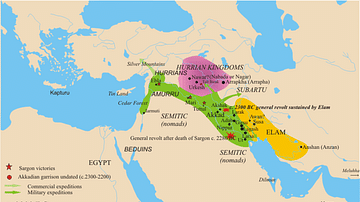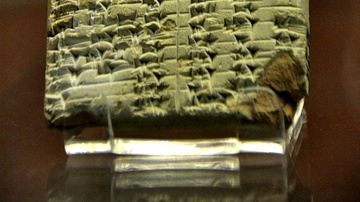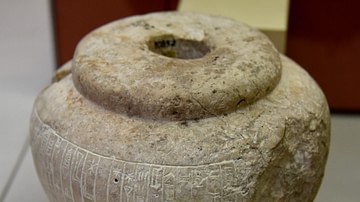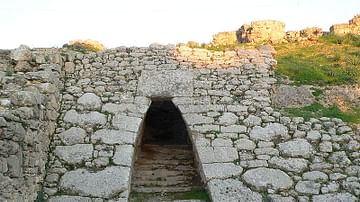Search
Search Results

Image
Map of the Akkadian Empire, c. 2334 - 2218 BCE
This map illustrates the rise and expansion of the Akkadian Empire, the first known empire in world history, emerging in Mesopotamia around the twenty-fourth century BCE. Originating from the city-state of Akkad, the empire under Sargon the...

Image
Map of the Akkadian Empire
The empire of Sargon, late 24th century BCE.

Image
Kassite-Akkadian Lexical Clay Tablet
Vocabulary giving the Akkadian equivalents of 48 Kassite words of the type found in personal names. The Kassite words are listed on the left of each column with their Babylonian equivalent to the right. 1200-800 BCE. From Babylon, Mesopotamia...

Video
Early Dynastic Mesopotamia | Ancient Documentary | The Sumerian and Akkadian Empires.
The Early Dynastic Period of Mesopotamia is the modern-day archaeological term for the era in Mesopotamian history — 2900-2334 BCE — during which some of the most significant cultural advances were made including the rise of the cities, the...

Definition
Mesopotamian Literature
Ancient Mesopotamian literature developed c. 2600 BCE after scribes, who had formerly been record keepers, began composing original works in the region of Sumer. The Sumerians invented writing c. 3500 BCE, refined the script c. 3200 BCE...

Article
The Mesopotamian Pantheon
The gods of the Mesopotamian region were not uniform in name, power, provenance or status in the hierarchy. Mesopotamian culture varied from region to region and, because of this, Marduk should not be regarded as King of the Gods in the same...

Definition
Sargon of Akkad
Sargon of Akkad (r. 2334 - 2279 BCE) was the king of the Akkadian Empire of Mesopotamia, the first multi-national empire in history, who united the disparate kingdoms of the region under a central authority. He is equally famous today as...

Definition
Mesopotamian Government
Ancient Mesopotamian government was based on the understanding that human beings were created to help and serve the gods. The high priest, king, assembly of elders, governors, and any other officials were recognized as stewards chosen by...

Definition
Gutians
The Gutians were a West Asiatic people who are thought to have lived around the Zagros Mountains in a region referred to as Gutium. They had no written language and all that is known of them comes from their enemies, including the Akkadians...

Definition
Ugarit
Ugarit was an important sea port city in the Northern Levant. Though never a world power, Ugarit was a key economic center in the Ancient Near East, serving as a major trade center between Egypt and the major powers of Bronze Age Asia Minor...